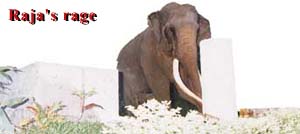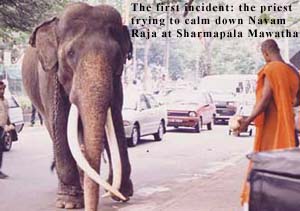 |
 9th August 1998 |
Front Page| |
 It's cool and comfy - Travel |
Contents
|
|
 |
Raja's rageWhy did Navam Raja run amok and kill its mahout shortly before the Esala Perahera? Hiranthi Fernando reports
Navam Raja, the majestic elephant with the long crossed tusks is now tethered alone in a shed at the back of the Diyawadane Nilame's official residence close to the Dalada Maligawa. He stands there swinging his trunk and flapping his ears. He is fed and bathed but no one dares to go near him except Ven. Galboda Gnanissara Thera, also known as Podi Hamuduruwo from Gangaramaya. "It happened at around 4.30 on Friday evening, on Malabar Street," recalled Neranjan Wijeratne, the Diyawadane Nilame. "I saw the elephant myself that morning and fed it with bananas." Mr. Wijeratne said that Navam Raja had carried the relics at the perahera the day before this incident and was due to carry the relics that day as well.
The elephants are chained to concrete blocks on this stretch of road between the Diyawadane Nilame's residence and the Dalada Maligawa after their bath. They are given their evening meal of leaves and kitul stumps and allowed to feed at leisure until they are robed for the Perahera. "That evening, when I came there to tie my elephant after his bath, Navam Raja was chained in my place," Somaratne said. "I asked the keeper Dingiri Mahattaya to vacate the place for my elephant. He leaned his hook against the wall and removed the chain from the back leg of the elephant. As there was a small branch entangled with the chain, Dingiri Mahattaya bent to remove it. The elephant suddenly knocked him over with his tusk, gored him and flung him up to the electric wire. All of us, other mahouts who were nearby, pelted the elephant with stones and he stepped back. Dingiri Mahattaya fell behind a large log that lay in the corner. As the elephant came looking for him again, we pelted more stones. We managed to extricate the bleeding Dingiri Mahattaya from the corner. Fearing he would attack my baby elephant, I also unchained him and took him away. "Dingiri Mahattaya trusted the elephant and never imagined that he could be injured. We did not hear him uttering a word or scream through all this. We only heard his golaya (assistant) shouting 'Dingi Aiya, Dingi Aiya.'" S.A. Seneviratne, the mahout attached to the Maligawa, said he was returning from the Diyawadane Nilame's residence after bathing some elephants there, when he saw the commotion on the road. The injured mahout was rushed to the hospital in a police jeep but he succumbed to his injuries. The veterinary surgeon arrived with a tranquilizer injection but the Podi Hamuduruwo of Gangaramaya who was in Kandy did not wish it to be administered. He rushed over and calmed the elephant by feeding with kavun and bananas. When he was calm, the Podi Hamuduruwo retied the chain, Seneviratne recalled. The next day, they took the elephant back to the Diyawadane Nilame's residence and tied him in a shed there. He has now loosened one chain and is secured with only one. When he gets annoyed he apparently throws logs or stumps at anyone who comes near. "I feel that this was done in a sudden fit of temper," Seneviratne said. "Maybe, the mahout annoyed him." He explained that Navam Raja usually comes into musth regularly every April. During the period of musth, which in his case lasts about four months, he is kept tied to a tree. Fierce elephants are tied a week or so before they are expected to come into musth. He is fed and bathed without removing the chains, as elephants are unreliable at that time. He was untied recently after his period of musth. According to Seneviratne, Navam Raja had apparently attempted to attack another keeper at Kataragama last year. However, the mahout was able to calm him and bring him under control. Mr. Dassanayake, the Officer -in -Charge of the Police Post at the Maligawa said that the incident which was first reported to the Special Operations Room near the Dalada Maligawa, is being further investigated by the Kandy Police. Dr. Neville de Silva, the Veterinary Surgeon who treats the temple elephants feels that Navam Raja is still in musth and this is the cause of his aggressiveness. "His body condition is very good now and certain animals behave in this manner when they are in musth. In some animals, the musth lasts longer and it is difficult to predict the period," he said. "I noticed some secretions from the glands and also abnormal behaviour. However, some elephants are good tempered even during musth." Since this incident occurred, two other elephants who show signs of coming into musth have been kept away from the perahera. Jayantha Jayewardene, an authority on elephants, agreeing with the doctor says one of the most likely reasons for this kind of behaviour in an elephant is that he could be in musth. He explained that male elephants come into musth every year. It is seen by the secretion of an oily substance from a gland between the eye and the ear. This is a sign of musth, together with aggressive behaviour which is usual during this time. He commented that as it is prestigious when an elephant participates at the Kandy Esala Perahera, mahouts of elephants in musth sometimes wipe off traces of the oily secretions from the face of the elephant so that the signs of musth are not visible. Jayawardene added that an elephant gets into musth when he is in very good body condition. Although the musth period is not directly connected with reproduction, it is usually the elephants in musth that mate. "In the wild, male elephants have to fight for the female. It is nature's method of breeding to ensure that the best animal mates with the female," he said. The pressure in the musth gland creates pressure in the head which is the cause of the anger and aggressiveness. The first person he turns to attack is usually the mahout. In the case of tame elephants in musth, they are tied up during this period, which tends to increase their aggressiveness. Wild elephants roam free while in musth and they are able to rub their heads against a tree and get the oily substance off. This releases the pressure in the head. As a result, wild elephants in musth are less dangerous than tame ones. Whatever the causes for this tragic incident it raises the question whether greater precautions need to be exercised on such occasions as the Kandy Perahera when large numbers of elephants are tethered for long hours, exposed to various irritation.
More Plus * Heartache! * Smoking causes cancer, no?
Front Page| News/Comment| Editorial/Opinion| Business| Sports | Mirror Magazine |
|
 |
Please send your comments and suggestions on this web site to |
|
 What
makes a tame elephant suddenly run amok and attack? On Thursday July 23
Navam Raja, an elephant from the Gangaramaya Temple ran amok at the Dharmapala
Mawatha/Green Path roundabout in Colombo chasing a keeper, and holding
up traffic at the busy junction for half an hour. A priest from the Gangaramaya
succeeded in calming him down with offerings of sweets. Eight days later,
at Kandy, where he was taken to participate at the Esala Perahera, he again
went berserk, killing his own mahout in a fit of rage.
What
makes a tame elephant suddenly run amok and attack? On Thursday July 23
Navam Raja, an elephant from the Gangaramaya Temple ran amok at the Dharmapala
Mawatha/Green Path roundabout in Colombo chasing a keeper, and holding
up traffic at the busy junction for half an hour. A priest from the Gangaramaya
succeeded in calming him down with offerings of sweets. Eight days later,
at Kandy, where he was taken to participate at the Esala Perahera, he again
went berserk, killing his own mahout in a fit of rage.  L.W.R.
Somaratne Banda of Galathara, Mawanella, was an eye witness to the incident.
He is the keeper of a nine year old baby elephant who is usually tethered
next to Navam Raja.
L.W.R.
Somaratne Banda of Galathara, Mawanella, was an eye witness to the incident.
He is the keeper of a nine year old baby elephant who is usually tethered
next to Navam Raja. In
the absence of Podi Hamuduruwo, who had gone to Kandy again to see Navam
Raja, another monk at Gangaramaya spoke about the background of the tusker,
who he said was about 37 years of age.
In
the absence of Podi Hamuduruwo, who had gone to Kandy again to see Navam
Raja, another monk at Gangaramaya spoke about the background of the tusker,
who he said was about 37 years of age.